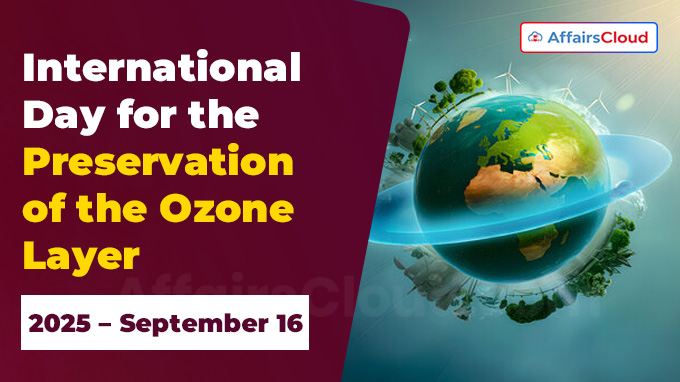
The United Nations (UN’s) International Day for the Preservation of the Ozone Layer, or World Ozone Day (WOD) or Global Ozone Day, is annually observed across the globe on 16th September to raise awareness about the significance of the ozone layer and the impact of its depletion, which contributes to global warming and climate change.
- 16th September 2025 marks the 31st observance of the International Day for the Preservation of the Ozone Layer.
Exam Hints:
- Event: International Day for the Preservation of the Ozone Layer 2025
- When? September 16
- Theme 2025: “From Science to Global Action”
- Purpose: Raise awareness about the ozone layer, its depletion, and climate change impact.
- First Observance: 22 March 1985
- Organiser in India: MoEF&CC
- India’s HFC reduction: 67.5%
Theme:
The theme for International Day for the Preservation of the Ozone Layer 2025 is “From Science to Global Action.”
Background:
UNGA Resolution: On 19 December 1994, the United Nations General Assembly (UNGA) adopted resolution A/RES/49/114, declaring 16 September of every year as the International Day for the Preservation of the Ozone Layer.
First Observation: The inaugural International Day for the Preservation of the Ozone Layer was observed on 16 September 1995.
Why 16 September? The date 16 September marks the signing of the Montreal Protocol on Substances that Deplete the Ozone Layer in 1987.
About Ozone:
Nature and Role of Ozone: Ozone (O₃) is a colourless, odourless, and reactive gas, different from the oxygen (O₂) we breathe. Most ozone is in the stratosphere, where it absorbs harmful UV (ultraviolet) rays, protecting life on Earth.
Location: 15–50 kilometers (km) above Earth, absorbs harmful Ultraviolet B radiation(UV-B) radiation.
Ozone Hole: The ozone hole is a region over Antarctica with very low ozone concentration. It is not a literal hole, but it weakens the ozone layer’s protection against UV radiation.
About Montreal Protocol:
Protocol: The Montreal Protocol, enforced in 1989, is the first treaty to achieve universal participation, having been ratified by 198 countries.
- It was designed to protect the ozone layer by eliminating ozone-depleting substances.
Implementation: Achieved phase-out targets ahead of schedule in many cases; accelerated timelines for HCFCs (final phase-out by 2030 in developed and 2040 in developing countries).
Vienna Convention:
Convention: The Vienna Convention, adopted on 22 March 1985 and effective from 1988, provides a legal and practical framework for protecting the Earth’s ozone layer and promotes international cooperation among 28 signatory countries.
Universal Ratification: On 16 September 2009, the Vienna Convention along with the Montreal Protocol, became the first UN treaties to be universally ratified by all countries.
Kigali Amendment:
Focus on HFC Reduction: The Kigali Amendment, agreed on 15 October 2016 at Kigali, Rwanda, under the Montreal Protocol, aims to gradually reduce HFCs used in refrigeration and air-conditioning.
Climate Impact: Full ratification and implementation of the amendment could help limit global warming by up to 0.5°C (degree Celsius) by the year 2100.
WMO Ozone and UV Bulletin 2025:
According to the World Meteorological Organization (WMO)’s WMO Ozone and UV Bulletin released in September 2025, the ozone layer is on track to recover in the coming decades, with the 2024 ozone hole smaller than in previous years.
- The Bulletin also emphasizes that continued monitoring of stratospheric ozone and UV radiation is essential to protect human health, ecosystems, and food production, with WMO’s Global Atmosphere Watch Programme providing crucial data, analysis, and capacity-building support.
2025 Events in India:
Event: On 16 September 2025, the Ministry of Environment, Forest and Climate Change (MoEF&CC) organised the 31st World Ozone Day in New Delhi, Delhi.
Dignitaries: Union Minister Bhupender Yadav, MoEF&CC; Tanmay Kumar Secretary (MoEF&CC); Angela Lusigi, United Nations Development Programme (UNDP) Resident Representative in India; Rajat Agarwal, Joint Secretary (MoEFCC) were also present at the event.
Montreal Protocol Publication: During the event, the 27th edition of ‘The Montreal Protocol: India’s Success Story’ was released, showcasing India’s achievements in phasing out ozone-depleting substances.
India’s Cooling Leadership: Union Minister Bhupendra Yadav, MoEF&CC, announced that India became one of the first countries globally to implement a Cooling Action Plan.
- India has achieved a 67.5% reduction in the production and use of HFCs.
- India Cooling Action Plan (ICAP, 2019) was launched under Prime Minister (PM) Narendra Modi, demonstrates strong inter-ministerial and cross-sectoral coordination, aiming to reduce cooling demand by 20–25%, energy use by 25–40%, and refrigerant demand by 25–30% by 2037–38.
India’s Achievements under the Montreal Protocol: CFCs, carbon tetrachloride, and halons phased out by 2010 ahead of schedule.
- ODS (Regulation & Control) Rules, 2000; banned CFCs and halons in new equipment by 2003.
- Advocated for developing nations; secured Multilateral Fund (MLF) in 1990.
Met 2013 freeze and 2015 10% reduction targets under HCFC Phase-out Management Plan (HPMP) Stage-I.




